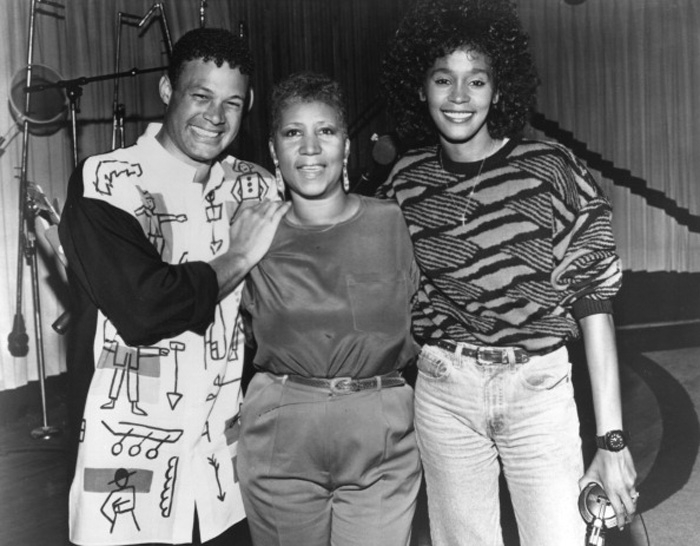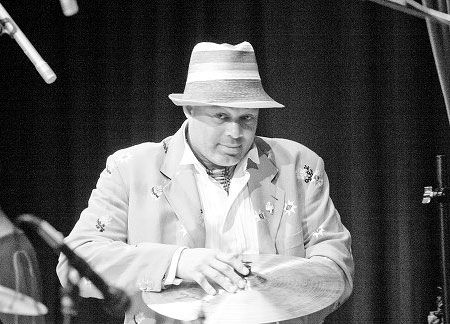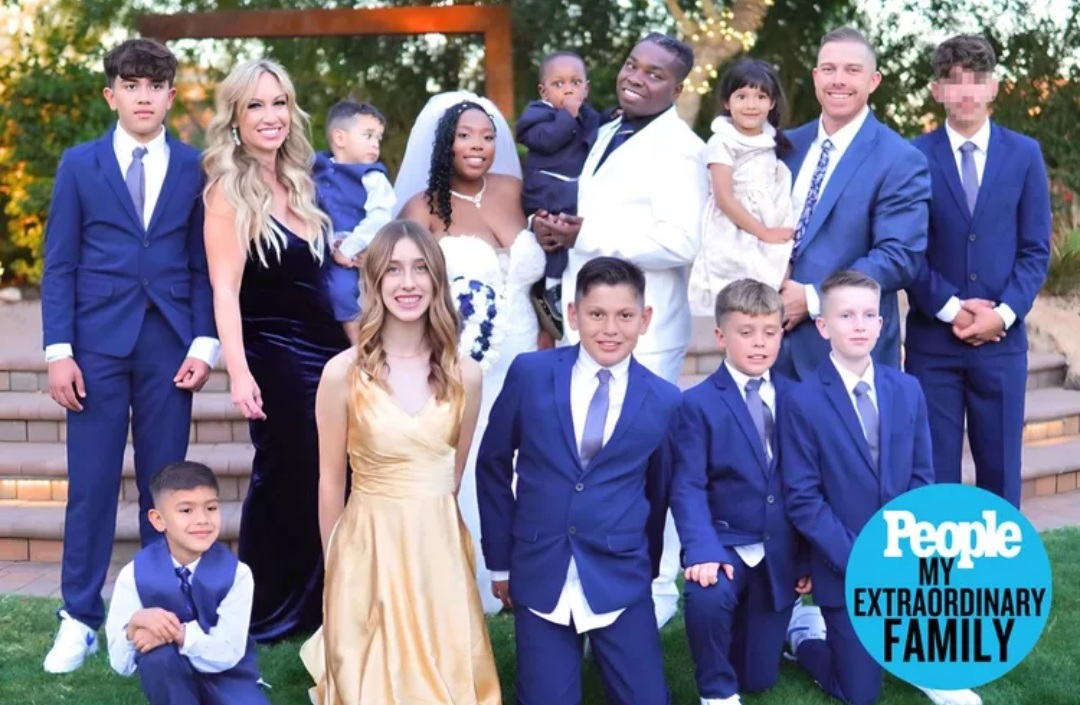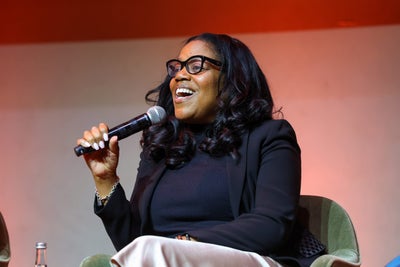
by Michael P. Coleman
Narada Michael Walden cut his production teeth with a pre-pubescent Stacy Lattisaw, coaxing a series of stunning R & B and pop vocal performances out of a girl who couldn’t possibly have lived enough to have found “love on a two-way street”, let alone to have “lost it on a lonely highway”. Those Lattisaw ballads —“Let Me Be Your Angel”, “Miracles”, “Memories”, “My Love”, and “I’ve Loved You Somewhere Before”among them —foretold the magic Walden was to create just a few years later with an emerging Whitney Houston. A brilliant musician and performer in his own right, Walden went on to produce masterpieces for Houston and other music industry royalty including Diana Ross, Aretha Franklin, Mariah Carey, and Angela Bofill
The spring issue of The Hub magazine includes a portion of my interview with Walden, during which he talked about his work with Aretha on two of her classic 80s albums, Aretha and Through The Storm. However, with a resume like Walden’s, I HAD to ask him about his projects with rest of the legends he’s worked with. The two of us sat down in Walden’s Tarpan Records studio and he told me stories about how Lattisaw saved his career, how Prince and Tina Turner inspired Walden’s work with a “tender”Aretha Franklin during their landmark Who’s Zoomin’Who? sessions, sparks flying in the studio with Diana Ross, his relationship with Quincy Jones, and Whitney’s “fearlessness”. He also told me about meeting Mariah Carey —and just how early Sony chief Tommy Mattola became interested in her romantically — and about the diva who actually rejected Walden’s songs and passed on a chance to work with him! Here’s Part 2 of my exclusive conversation.
This interview has been edited.

A: We had that connection. She was only 11 years old when we first worked together. At the time, I wasn’t a pop producer. I only had produced my own records, having redirected my career from jazz/rock/fusion to dance. I had been told soon after moving to San Francisco that, if I didn’t get a hit, I was going to be dropped from Atlantic Records. I’d had two albums at that point that hadn’t hit. In 1978, I was working on the third, Awakening, and it had some fusion on there and Atlantic said ‘You know what, disco where it’s at right now.” Rick James had just had a big smash with “You & I”. So I said ‘Let me jump on that train.’I started banging some things out, and in two days I had what became side one of Stacy’s Let Me Be Your Angel album. Stacy was Henry Allen [Atlantic’s CEO]’s protege, so I asked him to let me produce four songs on her, and he agreed that if he liked them I could do four more and he’d have an entire album. I wrote those first four songs: Let Me Be Your Angel, Dynamite, Jump To The Beat, and My Love. We cut those tracks with Stacy in two days, and I delivered those first songs under budget. Atlantic was thrilled, and they gave me the rest of the album, and that’s how I launched my career as a producer. That project saved my career. After I started hitting as a producer, Clive Davis started calling me and asked how I was making all of those great records and asked how I felt about producing Dionne Warwick or Aretha Franklin. I told him I’d love to, and he opened his Arista catalog to me. I got with Angela Bofill and Phyllis Hyman through Clive. Then Kenny G came through. All of these things started happening because of Stacy’s success.
Tell me about Mariah Carey and “I Don’t Wanna Cry”. How did that project come about?
I got a phone call from the president of Sony, Tommy Mattola, who said he’d found someone who’s really, really incredible. He told me not to go after her —he was already romantic with her, had romantic feelings towards her. It was already that special for him. I was fine with that —I was married and everything, you know? He wanted to send me a song so I could hear her, and I said that was fine. He sent me a little tiny picture of her and a cassette of just one song, so I could hear her kind of riffing. I could tell she was great just from the riffing. So I went to New York and I met Mariah. She was extremely shy. She would only kind of look at you through one eye, you know, with her hair over the other eye but looking at you with the one eye. I wrote four songs for her, including “There’s Got To Be A Way”and the song that became “I Don’t Wanna Cry”. The inspiration for that song was I’d told Mariah that when I was a young boy, I’d seen this singer named Walter [Jackson] who was in a wheelchair. They wheeled him out on stage, and he sang this song called “It’s An Uphill Climb To The Bottom”. And at the end of the song, he falls out of his chair and onto the floor! And he’s singing really high —and beautifully —while he’s lying on the floor! That image never left me —the visual and the audio of what he was doing. I told Mariah that she was a brand new artist who needed to have something that will create that kind of drama. And out came “I Don’t Wanna Cry”. I gave her the melody and framework of the song, and she finished writing the lyrics.
Tell me about your work with Tevin Campbell.
Tevin is a little genius. Quincy Jones is my guru, and he was the one who really pushed me to take production more seriously, saying that people needed help making good records. He asked me if I wanted to produce Tevin. Quincy flew up in his Warner Brothers jet with Tevin and his mother. I met with Tevin and just asked him “Tell me what you want to do”. And that song came out of that. I could see him still being innocent, but asking a girl “tell me what you want me to do.” So you make the music really simple. That’s what all the soul singers need to really do their thing. If the chords move around too much, they can’t really get off the same way. With some singers, like Dionne Warwick, the melody is so powerful, and they can just sing the melody, and that’s ok. But with Tevin, who’s like a gymnast with his voice —Aretha’s HIS guru! —you give him real simple chords and a good lyric, and he can kind of build and go crazy like he did on that record. And “Tell Me What You Want Me To Do”became a #1 for him. I’m still close to Tevin. I want to put him on our upcoming Tarpan Records compilation.

Quincy’s the kind of person who can just tell you everything about anything. His mind is so sharp. He knows dates. He can tell you when he met Stravinsky or Picasso or Duke Ellington. You just take it all in. With him, I’m a listener and he spews.
Let’s talk about Whitney Houston. Your book on your experiences with Whitney is the best book about her that’s been published because it focused on the work, on your projects together. That’s what we can all relate to. What can you say about Whitney, if anything, that you didn’t say in your book?
Thank you. It was a great honor to work with Whitney. She gave me a new level of confidence. When I first worked with her on “How Will I Know”, she was so easy because she knew the song really well, and she sang it so effortlessly, so well, so powerfully. It was a one or two takes kinda thing. And then when she was done, she just looked at me with this effortless vibration that she puts off. I remember thinking that I was in the presence of a new champion. And I had to sit down and take it all in for a moment. .
Talk about Whitney recording the duet with Aretha, “It Isn’t, It Wasn’t, It Ain’t Never Gonna Be” and the meeting of a young, budding superstar with the seasoned Queen of Soul.
Whitney was really slamming that day. She did a few riffs and runs that nobody could top, nobody, and when she was done she just kissed us both, me and Aretha, on the cheek and left Aretha there to try to top that. You have to understand the mentality of prizefighters. That’s what divas are: prizefighters. They’re born with it. It’s innate…in their blood. Joe Frazier. Mohammed Ali. They don’t call it competition. I have to stress that the confidence level was what was really outstanding about Whitney. From the very beginning, she wasn’t intimidated. She was a powerful soul. Fearless…absolutely fearless. A level of fearlessness that you might think of as reckless in another person. For instance, she knew the history in this room, the energy of the people who had preceded her, but she wasn’t intimidated by it.
Tell me about another legend that’s been in this studio: Diana Ross. The two of you on her Take Me Higher album were fire!
Okay! We had a good time making those records. She wanted some of the high that I was riding after Whitney. Diana was going through a lot at the time, I can tell you that, so that made things a little bit strained. She was about to enter into a divorce. Her husband was climbing the swiss mountains or something and she was in New York, and she was also very busy at the time. I remember having gotten a lot of the ideas, a lot of the records cut here, and I went to her to get her vocals, but those sessions were hard to schedule. One day, we’d have a recording day scheduled and she’d be booked on Oprah earlier the same day. I only had little windows of time in her schedule that I had to work with. Everything was going cool —“Take Me Higher”, it was her idea to want to do “I Will Survive”. She said she’d always wanted to cover it, and we worked to try to make it more unique than what the original is. The original’s killer, right? [LAUGHS]. But one day, one of those songs we cut was really difficult for her. It wasn’t a typical “Diana Ross”song —I think it was “If You’re Not Gonna Love Me Right”. It had some little runs that I wanted to work on with her. Due to her being tired and emotionally distraught, she got a little upset with me. Diana just stopped at one point and said ‘I’m not enjoying this!’. I realized she was just really upset about what was going on in her life, and that song was hard for her. At the time, I had flowers in the room for her, and I’d ask her to keep doing it, trying again to push her to make it what it could be. She raised her voice at one point, and I told her to calm down and just tell me what was going on. And she did, she opened up to me. And that was good! She let it all out. The next morning she called and thanked me for letting her vent, and I told her it was no problem —that’s what I’m there for. Recording’s hard as it is. And I’m meticulous. And she’s kinda meticulous, you know? And then with her going through a divorce, it was a hard time for her. But we had success together, and she was happy at the end. It all worked out. She was very sweet. She came to my house one day, and wanted to sit on the floor in my meditation room and just talk with me about meditation and prayer, about renewing your life.
Let’s talk about the albums you produced on Aretha Franklin. The first of them, 1985’s Who’s Zoomin’ Who?, stands as Franklin’s best selling album. That’s got to mean something to you.
I’d been to her house as we were preparing for that, and saw her gold singles on the walls, for “Chain Of Fools”and all of that. Those golds were for a half-million in sales. She and I together actually achieved million sellers, many times over. So that IS a big deal to me, you’re right. And that time was significant for me for another reason. It was a tough time for her to do anything, and would have been for anyone to work with her. Her father had just passed away after having been in a coma for two years. She hadn’t recorded in a little while. It was a very tender time for her to even be in the studio. I’m very happy that God blessed me with a song called “Until You Say You Love Me”. That was the first song I cut on Aretha. I remember she was so tender. She’d ask me to rub her shoulders just to kind of relax her. If I was rubbing like this [Walden demonstrates with me] it was too hard. That’s how tender, how sensitive she was. And she sang that song so beautifully for me. It was at the second session that I came back with “Zoomin’“and “Freeway”and all of that stuff. But “Until You Say You Love Me”was what broke the ice between us and got us started. I’m really fond of the production of that song. When I heard Prince do “The Beautiful Ones”, I took those drums and cut them twice as fast, and that’s the drumbeat on that song. Also, Luther [Vandross] had laid it out for her so cold-blooded with “Jump To It”. How were we gonna top THAT? And to be honest, we never did. I mean “Jump To It”is “Jump To It”!!! I turned to Quincy Jones and asked what he might do with Aretha. He told me he was feeling what Tina Turner was doing then, “What’s Love Got To Do With It”. So I took a conversation with Aretha when I asked her what she was doing at night, and she said she’d been to a nightclub, saw a guy, flirted with him a little bit, she talked about wondering who was zooming who, fish jumped off the hook and all of that, and I merged it with the feel of “What’s Love Got To Do With It”on my keyboards, and THAT’s “Who’s Zooming Who?”. I was inspired by Tina Turner. She was taking soul, black, the church into the rock arena. So I used her as inspiration when I was cutting Aretha’s vocals. I always think about that with productions. I try to marry different worlds.
How easy was it to direct Aretha Franklin in the studio? Did you find her to be a diva?
Aretha is a very disciplined person. She won’t come to the studio unless she’s got the song really down. And when I say down, I mean memorized. There’s no lyric sheet in front of Aretha when she records. So all of the little ad-libs you hear on Aretha’s records? They’re all worked out ahead of time, everything she wants to do. Like on “Freeway Of Love”, “Make a left turn on Better Than Ever Street.” She’s already thought up those things. They’re not written down, but she knows what she wants to say.
When you started recorded with Franklin, she was smoking pretty heavily, but she stopped in the the late 80s. Did you hear a difference in her after she stopped smoking?
Oh yeah. Her highs came back. She was proud of that. She loved the sound she was getting once she stopped. When I mixed her music, she’d ask me “Where are my highs?”, what we think of as “treble”. She wanted her highs left in there!
Aretha biographer David Ritz told me that he thought Aretha was the same hits-driven artist that she was fifty years ago. He said she’s hungry for the next hit, and used the example of Aretha covering Barbra Streisand’s “People” first in 1964, and again last year on her new album. Did you see her in the 80s, when you first began working with her, as a “hits-driven” artist?
[Pause] That’s one way of saying it. I know I’m that way. And I know that she is a genius, and wants to be successful. So I’d have to say yes. But what you have to tap on is this: some artists don’t know their own hit when they hear it. Like Aretha didn’t like “Who’s Zooming Who?” She wasn’t going to record it. It took Clive Davis telling her ‘Just sing the song!’ Dionne Warwick, who I adore…when I met with her, she didn’t like any song I played for her.
Which songs did you demo for Dionne?
Before I got with Aretha, I went to Dionne’s house and played all kinds of songs for her! She didn’t like any of them. But then Clive Davis said ‘Don’t worry about it. Do you want to work with Aretha Franklin?’ That’s how the Who’s Zoomin’Who? album happened. Whitney didn’t like many of the things I did on her. I had to rework, rearrange, recut them for her. Like “Where Do Broken Hearts Go?” I had to really recut it, and show how how we were going to work a song to allow her to make it her own. ‘Oh NOW I get it!’she’d tell me after hearing my arrangements.
What do you think of Aretha’s new collection of classics sung by other R & B and pop divas?
For me, I don’t need that. I want to hear Aretha as the innovator. Her covers are cool, but I don’t need an whole album of them. She should put her mind on new funk, creative funk.
Would you record with her again?
I’m dying to! She’s signed to Clive. And with him, he wants her to do these covers. My vibe is something fresh for her.
Tell me about you as an artist, like your album with The Thunder. Your music reminds me of Lenny Kravitz’.
The Thunder is kinda fusion-y, kinda rock-y. Not as R & B conscious. Lenny and I are kindred spirits. We come from loving Jimmy [Hendrix], but we’re black cats —Curtis Mayfield, Earth, Wind & Fire and all of that stuff. But we like the power, the guts of guitars. A lock of black people don’t acknowledge that they like guitar if it’s too raw. We like funk guitar, but if it’s too raw, we don’t acknowledge it and you often don’t get a black audience.
Can you summarize your secret to all of the incredible hits you’ve produced for so many different artists?
R & B people are very picky with their music. You’ve gotta make sure, from the downbeat, it’s right. My thing has always been making that thing sound like what the ghetto’s gonna dig, what the nightclub’s gonna dig, what a little jukebox is gonna dig, what a little jacked up radio’s gonna dig. If it sounds good there, it’ll sound good on anything. I’m always after the production that’s gonna sound good on that little broke down street corner somewhere.
Michael P. Coleman is a Sacramento-based freelance writer. Connect with him at michaelpcoleman.com, via email, or tweet him: @ColemanMichaelP.



